warning FORD FIESTA 2007 Manual PDF
[x] Cancel search | Manufacturer: FORD, Model Year: 2007, Model line: FIESTA, Model: FORD FIESTA 2007Pages: 1226, PDF Size: 61.26 MB
Page 784 of 1226

303-03B-14 Engine Cooling - 2.OL Duratec-HE (M14) 303-03B-14
DIAGNOSIS AND TESTING
4. Observe the cooling system pressure tester make sure the pressure test reading
is
gauge reading for approximately two minutes. repeatable
and within acceptable gauge reading
The pressure should not drop during this time. limits of
the coolant expansion tank cap.
( If the system holds Pressure, proceed to Step 5. If the pressure test gauge readings are not 7. If the system does not hold pressure, check
within the acceptable gauge reading limits,
it thoroughly for coolant leaks.
INSTALL a new coolant expansion tank cap.
5. Check the engine for coolant leaks. Drain the
cooling system, repair any coolant leaks found
and fill and bleed the cooling system as
Thermostat Test
necessaw.
REFER to: Cooling System Draining, Filling and
Bleeding (303-03 Engine Cooling
- 2.OL
Duratec-HE (M14), General Procedures).
.Recheck the system by repeating Steps 3 and
4 at least twice.
Radiator Leak Test, Removed From Vehicle
CAUTI0N:Radiator internal pressure must
not exceed
130 kpa (20 psi) or damage may
result.
Clean the radiator thoroughly before leak testing
it, to prevent contamination of the water in the test
tank. Leak test the radiator in clean water with 138
kpa (20 psi) air pressure. Check it thoroughly for
air leaks. INSTALL a new radiator if necessary.
REFER to: Radiator (303-03 Engine Cooling
- 2.OL
Duratec-HE (M14), Removal and Installation).
Coolant Expansion Tank Cap Pressure Test
A WARNING:When releasing the system
pressure, cover the expansion tank cap
with a thick cloth to prevent the possibility
of coolant scalding, Failure to follow this
instruction may result in personal injury.
1. Remove the coolant expansion tank cap.
2. Use water to clean the area of the rubber seal
and pressure relief valve. Install the pressure
tester and adapter and immerse the coolant
-
expansion tank cap in water.
N0TE:lf the plunger of the pump is depressed too
quickly, an erroneous pressure reading will result.
3. Slowly depress the plunger of the pressure test
pump until the pressure gauge reading stops
increasing, and note the highest pressure
reading obtained.
4. Release pressure by turning the pressure relief
screw counterclockwise. Tighten the pressure
relief screw and repeat step 3 at least twice to
I. Connect the WDS to the data link connector
(DLC).
2. Using the WDS datalogger function, SELECT
the following sensors (as applicable to the
application):
IAT
- intake air temperature (IAT) sensor
ECT
- engine coolant temperature (ECT) sensor
CHT
- cylinder head temperature (CHT) sensor
LOAD
- engine load
VSS
- vehicle speed sensor (VSS)
RPM
- engine speed
DSRPM
- desired engine speed
The IAT sensor output is useful if the engine being
tested is cold or after an over-night cold soak. The
ECT sensor or CHT sensor and the IAT sensor
(
should either indicate the same value or be within
1 to 2 degrees Celsius of each other.
The ECT sensor output is important to display as
it indicates the engine warm-up and opening
temperature for the thermostat. It will initially
indicate a slightly higher reading just before the
thermostat opens and then drops back before
settling to a near flat line output (see graphic
below).
Item Description 1'. .
) A 1 Thermostat opens I\
B Thermostat settles into a cyclic open and
I I closure pattern
2006.0 Fiesta 1212006 G426582en
procarmanuals.com
Page 785 of 1226

303-03B-15 Engine Cooling - 2.OL Duratec-HE (M14) 303-03B-15
DIAGNOSIS AND TESTING
A CAUTI0N:lf the ECT sensor output reaches
the
120°C default line under normal cooling
system pressure, internal damage may be
caused to the engine and a diagnostic
trouble code (DTC) will be set in the PCM.
The test should be stopped and the cause
located and corrected. If the cooling
system does not pressurize, the coolant
will boil at
1 OO°C which may also damage
the engine. CARRY
OUT the Coolant
Expansion Tank Cap Pressure Test
Component Test in this section.
If the WDS only allows the ECT sensor to be
displayed in volts, refer to the following table for
corresponding Celsius values:
The CHT sensor output is useful to examine the
cylinder head temperature rise during the warm-up
cycle and later during the normal light throttle cruise
test. This sensor output may vary between vehicles
with manual transmission and vehicles with automatic transmission and should be used for
reference only.
Volts
1.33
1.02
0.78
0.60
0.46
0.35 0.27
The LOAD display is used for reference as it is
necessary to maintain a stable load line during the
test. It is necessary to carry out the test under
normal light throttle cruise driving conditions and
average loads, typically 40% to 70% of the load
value.
OCelsius
60
70
80
90
100
110
120 '
The VSS output is used for reference but can help
to identify misfires and sensors which fail during
the warm-up cycle.
The RPM display indicates the engine speed and
can be compared with the DSRPM.
The DSRPM is the desired or calculated idle speed
which the PCM commands the engine to reach. If
the thermostat opens too early (before the correct
opening temperature has been reached), the
engine will not reach this value. When
using the WDS in data logger mode, the
signals recorded should remain within the
DEFAULT values set by the WDS.
3m AWARNING:M~~~ sure that the WDS is
placed in the vehicle so that it does not
interfere with the safe operation of the
vehicle. Do not place the WDS in the
deployment path of any air bag. Failure to
follow these instructions may result in personal injury.
N0TE:The road test is best carried out with the
aid of another technician in the vehicle to enable
the vehicle to be driven safely while the sensor
outputs are monitored within datalogger. If there
is only one technician available, the WDS can be
set up (using the
recordlcapture mode camera
icon) before leaving the workshop to record a 16
km (1 0 mile) test.
N0TE:The results from the test are more
conclusive if the engine is cold when the test is
started.
Carry out a road test.
REFER to:
RoadIRoller Testing (1 00-00 General
Information, Description and Operation).
4. Drive the vehicle at a constant throttle opening
and set speed until the ECT value settles into
a shallow rise and fall signal, close to a straight
line. This indicates that the thermostat is
functioning correctly.
N0TE:Some thermostats indicate the
temperature(s) in Celsius and Fahrenheit.
The graphic below shows the location and an
example of the opening temperature
(88OC) and
fully open temperature (1
02OC) of a thermostat.
The graphic below shows an alternative method used to show the opening temperature
(88OC) and
fully open temperature
(112OC) of a thermostat.
2006.0 Fiesta 1212006 G426582en
procarmanuals.com
Page 787 of 1226
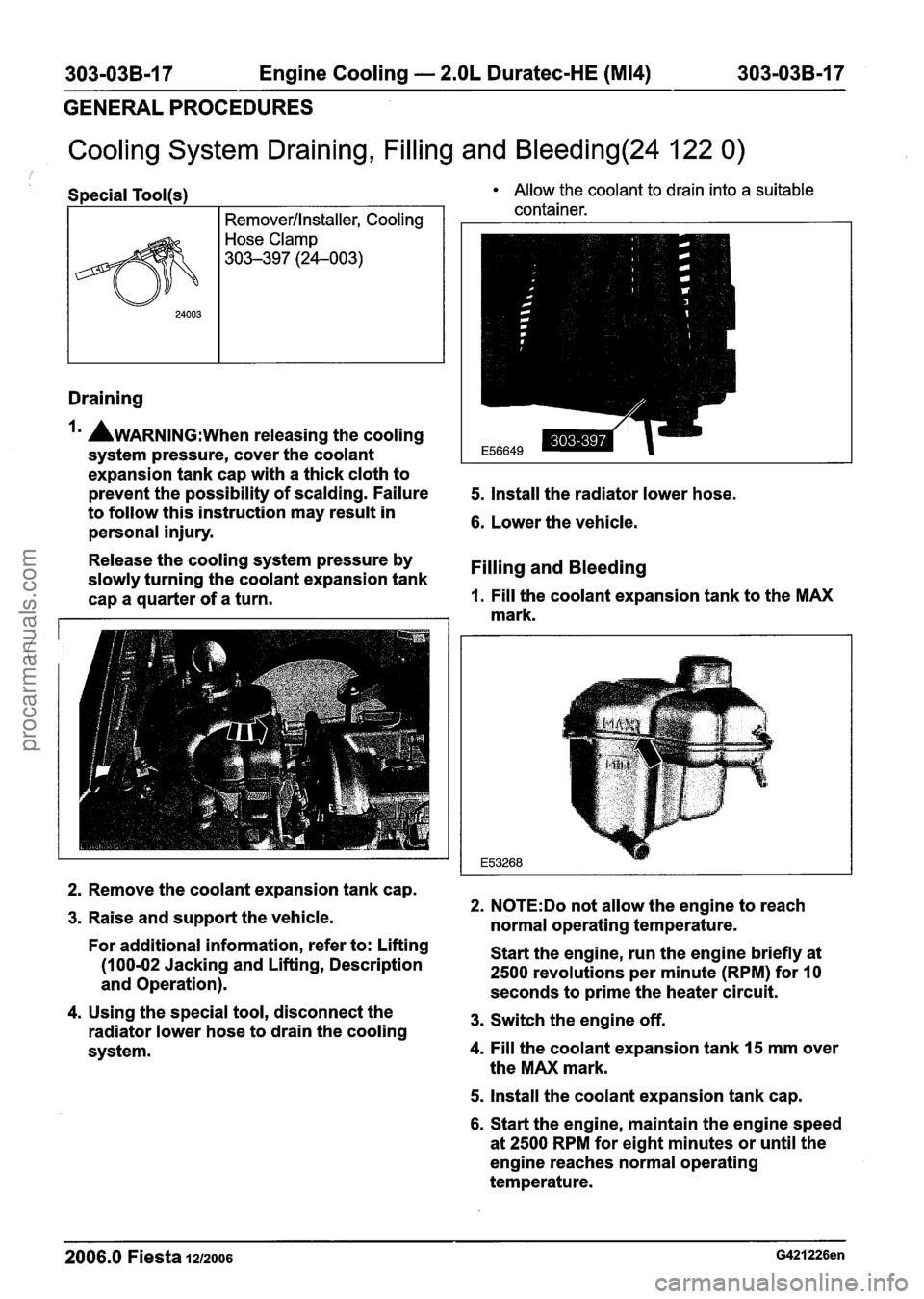
303-03B-17 Engine Cooling - 2.OL Duratec-HE (M14) 303=03B-17 --
GENERAL PROCEDURES
Cooling System Draining, Filling and Bleeding(24 122 0)
Draining
, Special Tool(s) Allow the coolant to drain into a suitable
Im AWARNING:~~~~ releasing the cooling
system pressure, cover the coolant
expansion tank cap with a thick cloth to
prevent the possibility of scalding. Failure
5. Install the radiator lower hose.
to follow this instruction may result in
personal injury.
6. Lower the vehicle.
Release the cooling system pressure by
slowly turning the coolant expansion tank
Filling and Bleeding
cap a quarter of a turn. 1. Fill the coolant expansion tank to the MAX
mark.
container.
24003
2. Remove the coolant expansion tank cap.
3. Raise and support the vehicle.
For additional information, refer to: Lifting
(1 00-02 Jacking and Lifting, Description
and Operation).
4. Using the special tool, disconnect the
radiator lower hose to drain the cooling
system.
Removerllnstaller, Cooling
Hose Clamp
303-397 (24-003)
2. N0TE:Do not allow the engine to reach
normal operating temperature.
Start the engine, run the engine briefly at
2500 revolutions per minute (RPM) for 10
seconds to prime the heater circuit.
3. Switch the engine off.
4. Fill the coolant expansion tank 15 mm over
the MAX mark.
5. Install the coolant expansion tank cap.
6. Start the engine, maintain the engine speed
at
2500 RPM for eight minutes or until the
engine reaches normal operating
temperature.
2006.0 Fiesta 1212006
procarmanuals.com
Page 805 of 1226
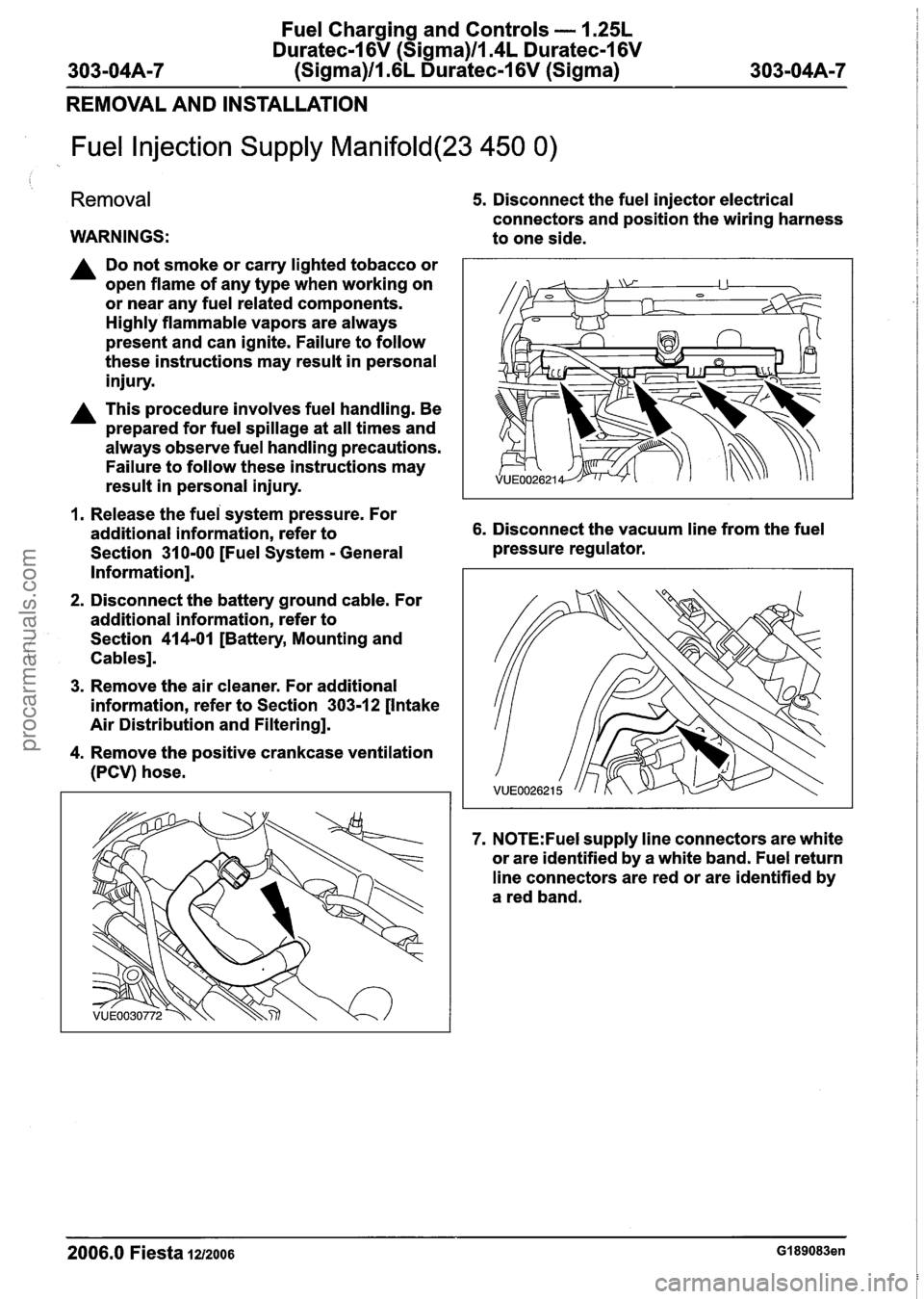
Fuel Charging and Controls - 1.25L
Duratec-1 6V (Sigma)llI4L Duratec-1 6V
303-04A-7 (Sigma)llI6L Duratec-1 6V (Sigma) 303-04A-7
REMOVAL AND INSTALLATION
Fuel Injection Supply Manifold(23 450 0)
Removal
WARNINGS:
A Do not smoke or carry lighted tobacco or
open flame of any type when working on
or near any fuel related components.
Highly flammable vapors are always
present and can ignite. Failure to follow
these instructions may result in personal
injury.
A This procedure involves fuel handling. Be
prepared for fuel spillage at all times and
always observe fuel handling precautions.
Failure to follow these instructions may
result in personal injury.
5. Disconnect the fuel injector electrical
connectors and position the wiring harness
to one side.
1. Release the fuei system pressure. For
additional information, refer to 6. Disconnect the vacuum line from the fuel
Section
31 0-00 [Fuel System - General pressure
regulator.
Information].
2. Disconnect the battery ground cable. For
additional information, refer to
Section
414-01 [Battery, Mounting and
Cables].
3. Remove the air cleaner. For additional
information, refer to Section
303-12 [Intake
Air Distribution and Filtering].
4. Remove the positive crankcase ventilation
(PCV) hose.
7. N0TE:Fuel supply line connectors are white
or are identified by a white band. Fuel return
line connectors are red or are identified by
a red band.
2006.0 Fiesta 1212006 GI 89083en
procarmanuals.com
Page 807 of 1226
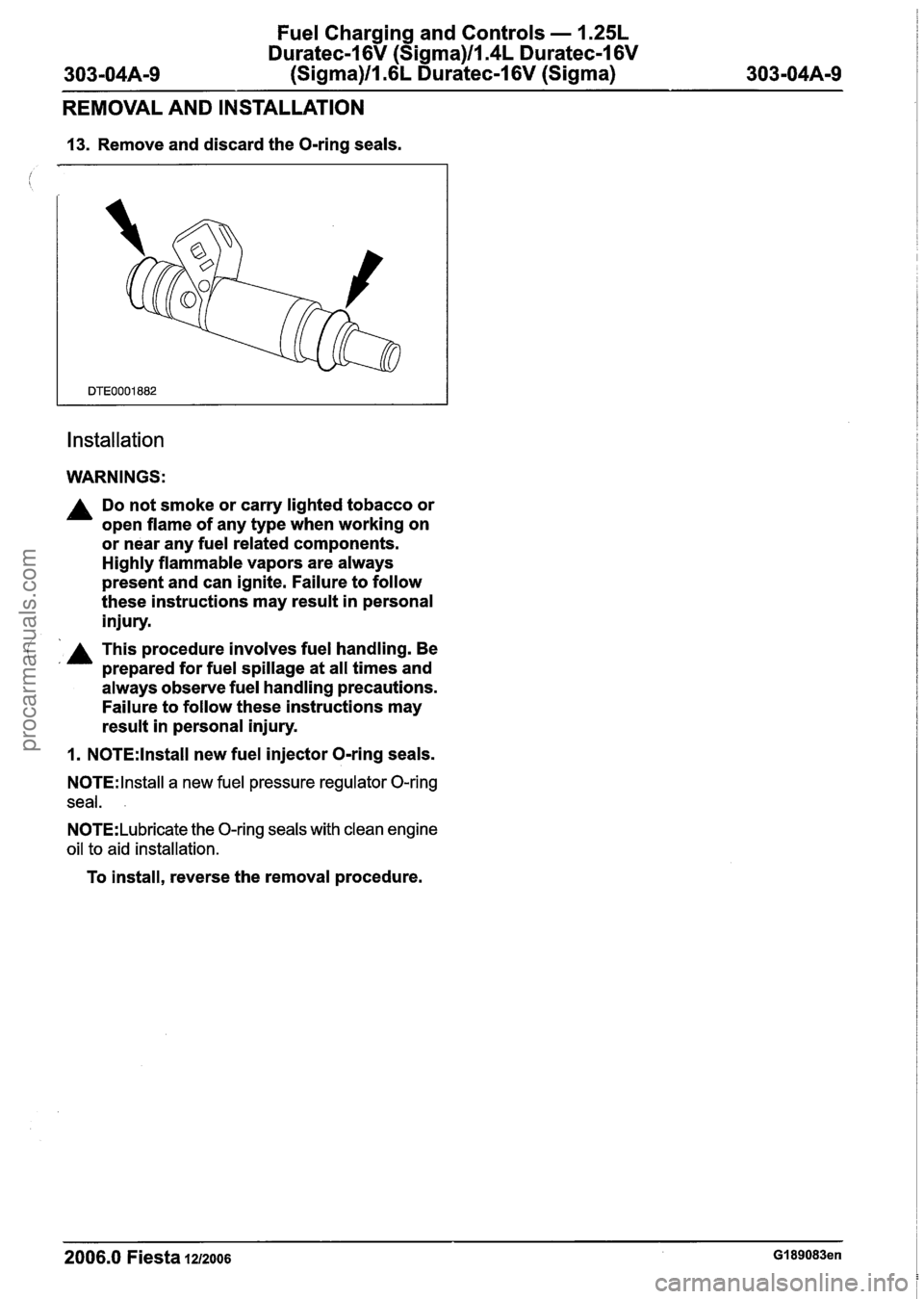
Fuel Charging and Controls - 1.25L
Duratec-I 6V (Sigma)llI4L Duratec-1 6V
303-04A-9 (Sigma)ll .6L Duratec-1 6V (Sigma) 303-04A-9
REMOVAL AND INSTALLATION
13. Remove and discard the O-ring seals.
Installation
WARNINGS:
A Do not smoke or carry lighted tobacco or
open flame of any type when working on
or near any fuel related components.
Highly flammable vapors are always
present and can ignite. Failure to follow
these instructions may result in personal
injury.
( A This procedure involves fuel handling. Be ' prepared for fuel spillage at all times and
always observe fuel handling precautions.
Failure to follow these instructions may
result in personal injury.
1. N0TE:lnstall new fuel injector O-ring seals.
N0TE:lnstall a new fuel pressure regulator O-ring
seal.
.
N0TE:Lubricate the O-ring seals with clean engine
oil to aid installation.
To install, reverse the removal procedure.
2006.0 Fiesta IZIZOO~ GI 89083en
procarmanuals.com
Page 835 of 1226
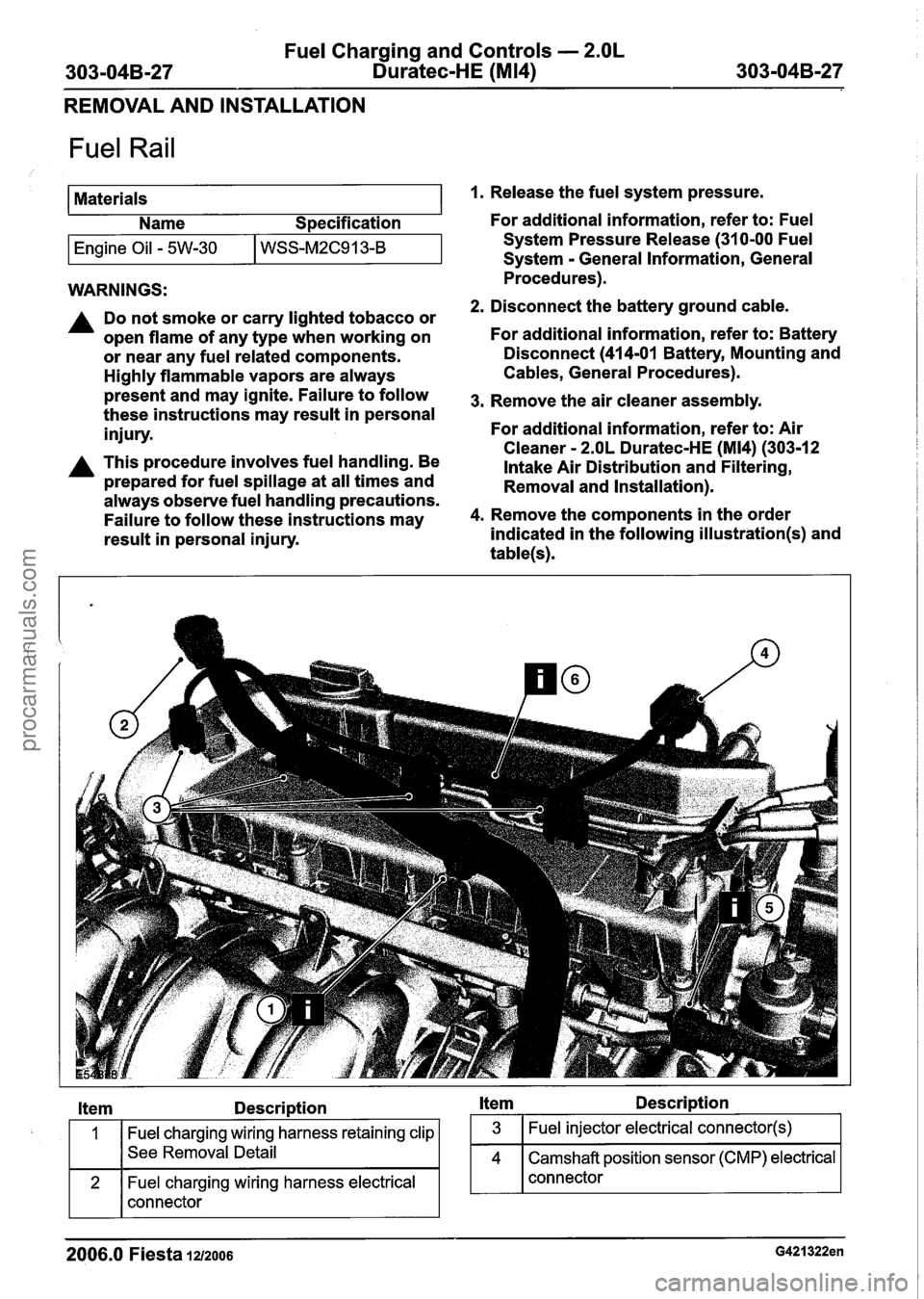
Fuel Charging and Controls - 2.OL
303-04B-27 Duratec-HE (M14) 303-04B-27
REMOVAL AND INSTALLATION
Fuel Rail
Materials Name Specification
I Engine Oil - 5W-30 I WSS-~2~91 3-B I
WARNINGS:
A Do not smoke or carry lighted tobacco or
open flame of any type when working on
or near any fuel related components.
Highly flammable vapors are always
present and may ignite. Failure to follow
these instructions may result in personal
injury.
A This procedure involves fuel handling. Be
prepared for fuel spillage at all times and
always observe fuel handling precautions.
Failure to follow these instructions may
result in personal injury.
1. Release the fuel system pressure.
For additional information, refer to: Fuel
System Pressure Release (31 0-00 Fuel
System
- General Information, General
Procedures).
2. Disconnect the battery ground cable.
For additional information, refer to: Battery
Disconnect
(414-01 Battery, Mounting and
Cables, General Procedures).
3. Remove the air cleaner assembly.
For additional information, refer to: Air
Cleaner
- 2.OL Duratec-HE (M14) (303-1 2
intake Air Distribution and Filtering,
Removal and Installation).
4. Remove the components in the order
indicated in the following
illustration(s) and
table(s).
Item Description Item Description
Fuel charging wiring harness retaining clip
See Removal Detail
Fuel charging wiring harness electrical
connector
2006.0 Fiesta 1212006 G421322en
procarmanuals.com
Page 836 of 1226

Fuel Charging and Controls - 2.OL
Duratec-HE (M14)
REMOVAL AND INSTALLATION
Description Item Description
See Removal Detail
See Removal Detail
Fuel charging wiring harness retaining clip
Item Description I . WARNINGS:
or near any fuel related components.
Highly flammable vapors are always
present and may ignite. Failure to follow
these instructions may result in personal
7
8
I I iniurv.
Fuel rail retaining bolts
Fuel rail A Do not smoke or carry lighted tobacco or
open flame of any type when working on
11
Removal Details
1 12 1 Fuel injectors
Item 1 Fuel charging wiring harness retaining
clip
Fuel injector O-ring seals
See Installation Detail
always observe fuel handling precautions.
1. Detach the fuel charging wiring harness
retaining clip from the intake manifold.
I w
A This procedure involves fuel handling. Be
prepared for fuel spillage at all times and
Failure to follow these instructions may
5. To install, reverse the removal procedure.
result in personal injury.
2006.0 Fiesta 1212006 G421322en
procarmanuals.com
Page 922 of 1226
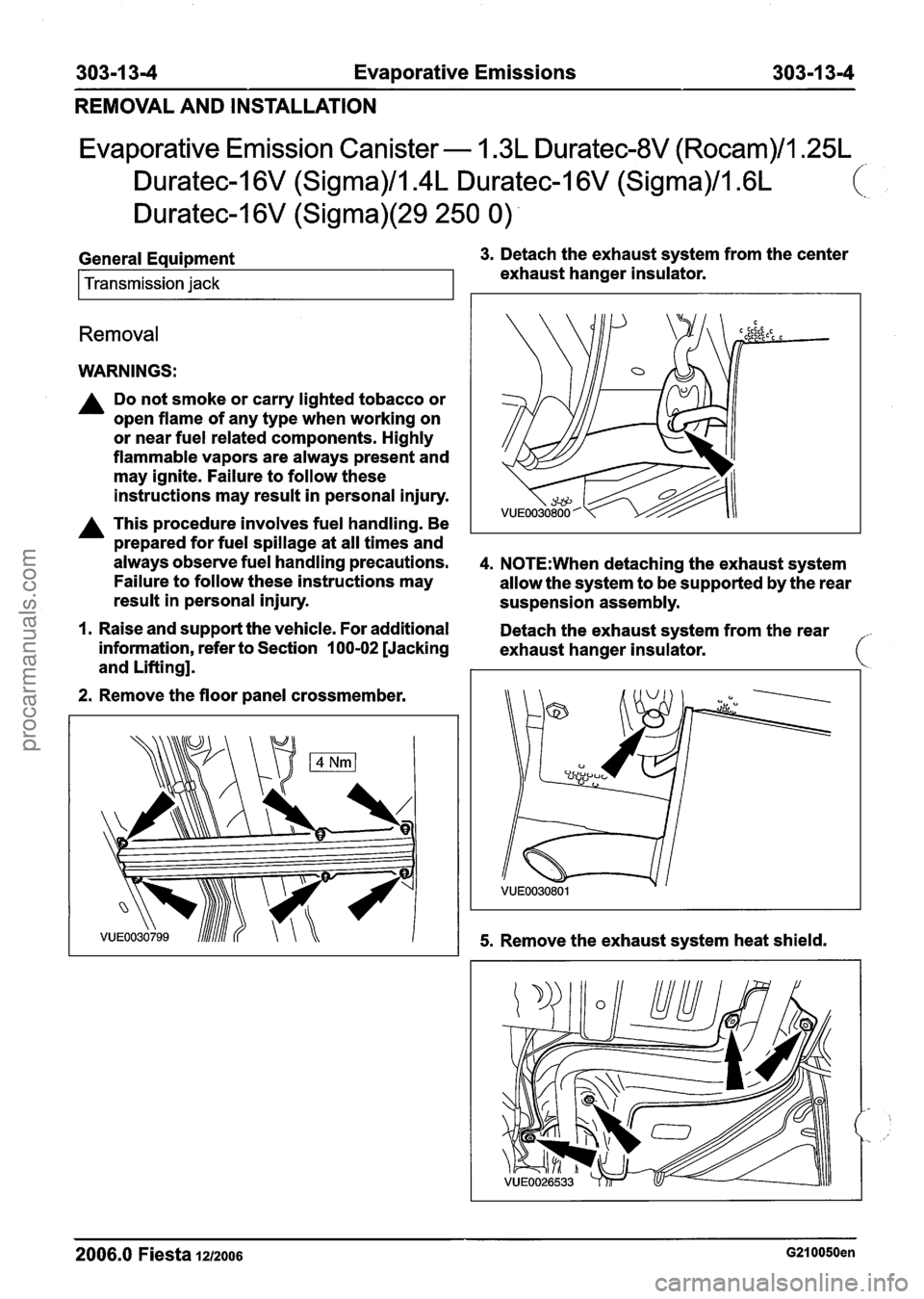
303-1 34 Evaporative Emissions 303-1 3-4
REMOVAL AND INSTALLATION
Evaporative Emission Canister - 1.3L Duratec-8V (Rocam)/l.25L
Duratec-1 6V (Sigma)/l.4L Duratec-I 6V (Sigma)/l .6L
Duratec-1
6V (Sigma)(29 250 0)
c
General Equipment 3. Detach the exhaust system from the center
Transmission jack exhaust hanger insulator.
Removal
WARNINGS:
A Do not smoke or carry lighted tobacco or
open flame of any type when working on
or near fuel related components. Highly
flammable vapors are always present and
may ignite. Failure to follow these
instructions may result in personal injury.
A This procedure involves fuel handling. Be
prepared for fuel spillage at all times and
always observe fuel handling precautions.
4. N0TE:When detaching the exhaust system
Failure to follow these instructions may
allow the system to be supported by the rear
result in personal injury.
suspension assembly.
I. Raise and support the vehicle. For additional
Detach the exhaust system from the rear
information, refer to Section
100-02 [Jacking
exhaust hanger insulator.
and Lifting].
2. Remove the floor panel crossmember.
5. Remove the exhaust system heat shield.
-
2006.0 Fiesta 1212006 G210050en
procarmanuals.com
Page 924 of 1226
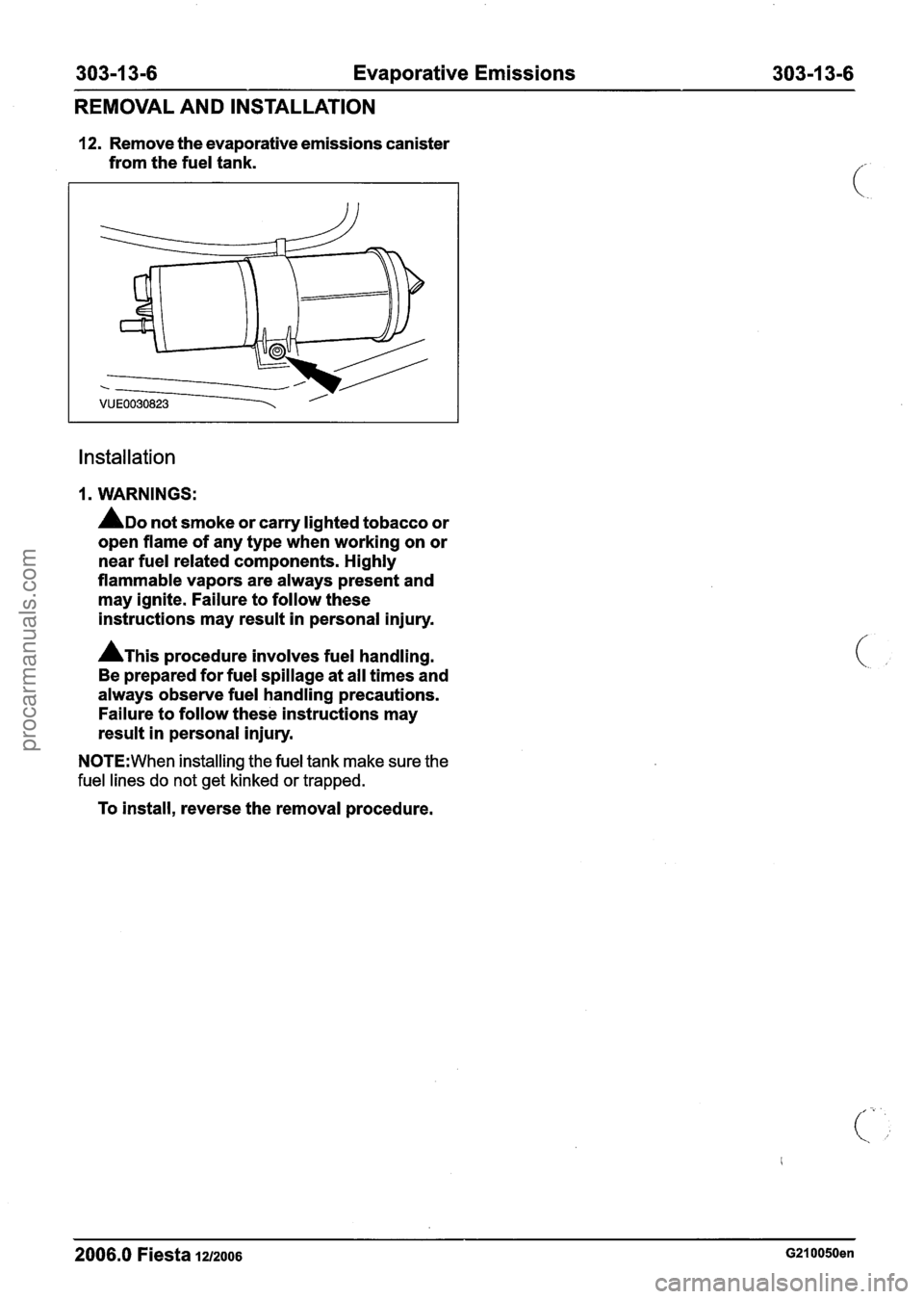
303-1 3-6 Evaporative Emissions 303-1 3-6
REMOVAL AND INSTALLATION
12. Remove the evaporative emissions canister
from the fuel tank.
Installation
1. WARNINGS:
ADO not smoke or carry lighted tobacco or
open flame of any type when working on or
near fuel related components. Highly
flammable vapors are always present and
may ignite. Failure to follow these
instructions may result in personal injury.
A~his procedure involves fuel handling.
Be prepared for fuel spillage at all times and
always observe fuel handling precautions.
Failure to follow these instructions may
result in personal injury.
N0TE:When installing the fuel tank make sure the
fuel lines do not get kinked or trapped.
To install, reverse the removal procedure.
2006.0 Fiesta 1212006 G210050en
procarmanuals.com
Page 933 of 1226

303-1 4-9 Electronic Engine Controls 303-1 4-9
DESCRIPTION AND OPERATION
If one potentiometer fails, the engine will run with
reduced power (maximum torque
80 Nm), if both
potentiometers fail, the engine will run with reduced
power (maximum torque
55 Nm).
This warning may also be indicated if the engine
does not start. The cause may be a poor state of
charge of the battery.
The warning indication normally disappears once
the battery is re-charged.
2006.0 Fiesta 1212006 G204204en
procarmanuals.com